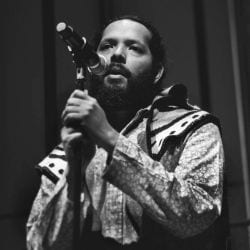Guadalupe Maravilla

Guadalupe Maravilla
Competition: US & Canada
In 1984, at eight years old, Guadalupe Maravilla immigrated alone to the United States from El Salvador in order to escape the Salvadoran Civil War. Maravilla was part of the first wave of undocumented children to come to the US from Central America. Maravilla became a US citizen at twenty-seven. In 2016, as a gesture of solidarity with his undocumented father, who uses Maravilla as his last name in his fake identity, Maravilla changed his birth name Irvin Morazan to Guadalupe Maravilla.
Maravilla creates fictionalized performances, videos, sculptures and drawings that incorporate his pre-colonial Central American ancestry, personal mythology, and autobiography. Through his multidisciplinary studio practice, Maravilla traces the history of his displacement, interrogates the parallels between pre-Columbian cultures and our border politics.
Maravilla has performed and presented his work extensively in venues such as the Whitney Museum of American Art, Metropolitan Museum of Art, Bronx Museum, El Museo Del Barrio, MARTE (El Salvador), Central America Biennial X (Costa Rica), XI Nicaragua Biennial, Performa 11 & 13, Fux-Box Festival, Exit Art, Smack Mellon, Rubin Foundation and the ICA in Miami (2019). Residencies include; LMCC Workspace, SOMA, Skowhegan and Drawing Center. Awards and fellowships include; Soros Fellowship: Art Migration and Public Space 2019, Creative Capital Grant 2016, Franklin Furnace 2018, Joan Mitchell Emerging Artist Grant 2016, Art Matters Grant 2013, Art Matters Fellowship 2017, Virginia Museum of Fine Arts Fellowship 2018, Dedalus Foundation Grant 2013 and The Robert Mapplethorpe Foundation Award 2003.
Artist Statement
Guadalupe Maravilla examines his own displacement and the geography of the Americas through a series of drawings. The artist reproduces new map drawings from the sixteenth-century manuscript Historia Tolteca Chichimeca, originally written in Nahuatl in Mexico. The manuscript presents a diagrammatic cartography of routes and passages of markets, dwellings, and displacements of an indigenous community colonized by Spain. On these maps, Maravilla traces imaginary immigration routes, sketches made by undocumented immigrants in the United States, as well as illustrations inspired by a Salvadoran game called Tripa Chuca, a pastime which consists of creating a map between two people through the use of lines and interconnected numbers. As a child, Maravilla immigrated alone to the United States from his native El Salvador. These drawings, then, document the history of his displacement and cultural exchanges are a collaboration between Maravilla and undocumented community.